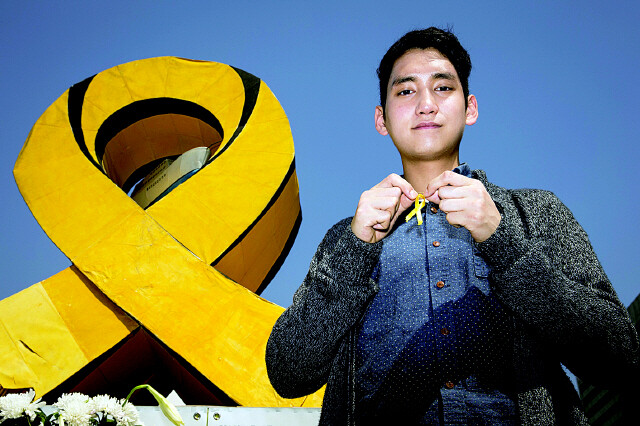hankyoreh
Links to other country sites 다른 나라 사이트 링크
Yellow Sewol ribbons have become a symbol of rebellion

In Gwanghwamun Square in central Seoul, where the families of the victims in the Sewol sinking have been staying in tents for close to a year, there is a large yellow ribbon sculpture that is waiting for the nine people who are still missing.
The yellow ribbons, which have become a symbol commemorating the victims in the tragic sinking of the ferry, started with a proposal by ALT, a coalition of university clubs, on Apr. 19, 2014, a few days after the ferry went down. Through social media like Facebook, the yellow ribbon campaign spread through South Korea and around the world, helping people share their sadness about the tragedy.
A Hankyoreh reporter met Yoon Sang-moo, 21, a student at Chung-Ang University who is president of ALT, at Gwanghwamun Square on Apr. 21. “It hurts me to see the message of hope and remembrance that the yellow ribbons are supposed to convey being appropriated for political ends,” Yoon said. “It’s more important for us to sympathize with the victims and their families.”
Over the past year, every time that there has been a demonstration commemorating the Sewol, people wearing the yellow ribbons have been stopped and questioned by the police or have been blocked from continuing on their way. For ordinary South Koreans, politicians, athletes, and even Hollywood stars visiting the country, a yellow ribbon pinned to their chests has effectively become a symbol of rebellion.
The yellow ribbon campaign was apparently inspired by a chance remark by the mother of a member of a university club who said that yellow ribbons express the hope that someone will return safely. While club members were brainstorming to come up with an image to use on Facebook and other social media, the phrase “a little action can create a great miracle” came into being as well.
At the time, seven members of ALT made 500 ribbons using yellow cloth that they bought at Dongdaemun Market and handed them out to passersby in Sinchon, Seoul. Little did they know that what had begun with 500 ribbons would go viral on social media.
“We wanted to go beyond just remembering the victims by communicating a message of hope and love. I no longer feel like we were the ones who invented the yellow ribbon. I think it has become something that belongs to all of us,” Yoon said.
But today, a year later, the yellow ribbon has become a target for random stops by police officers. “This reflects the attitude of South Korean society toward the Sewol,” Yoon said.
The demonstrations marking the first anniversary of the Sewol tragedy were shadowed by an excessively brutal response by the police. “They seem to see the families of the Sewol victims not as people whom we should be sympathizing with and whose pain we should be comforting but rather as some kind of anti-government activists,” Yoon said sadly.
Yoon called on South Koreans to take interest in the pain of the victims’ families and to sympathize with them once more.
“I was shocked when I heard people ask why the victims’ families were demonstrating now that they had gotten the money. 295 people were killed and nine are still missing. They’re still dealing with that pain. I think that right now it’s more important for us to sympathize with and try to understand their suffering than to criticize and bash them. That’s also part of the meaning of the yellow ribbon.”
By Heo Seung, staff reporter
Please direct questions or comments to [english@hani.co.kr]

Editorial・opinion
![[Column] Park Geun-hye déjà vu in Yoon Suk-yeol [Column] Park Geun-hye déjà vu in Yoon Suk-yeol](https://flexible.img.hani.co.kr/flexible/normal/500/300/imgdb/original/2024/0424/651713945113788.jpg) [Column] Park Geun-hye déjà vu in Yoon Suk-yeol
[Column] Park Geun-hye déjà vu in Yoon Suk-yeol![[Editorial] New weight of N. Korea’s nuclear threats makes dialogue all the more urgent [Editorial] New weight of N. Korea’s nuclear threats makes dialogue all the more urgent](https://flexible.img.hani.co.kr/flexible/normal/500/300/imgdb/original/2024/0424/7317139454662664.jpg) [Editorial] New weight of N. Korea’s nuclear threats makes dialogue all the more urgent
[Editorial] New weight of N. Korea’s nuclear threats makes dialogue all the more urgent- [Guest essay] The real reason Korea’s new right wants to dub Rhee a founding father
- [Column] ‘Choson’: Is it time we start referring to N. Korea in its own terms?
- [Editorial] Japan’s rewriting of history with Korea has gone too far
- [Column] The president’s questionable capacity for dialogue
- [Column] Are chaebol firms just pizza pies for families to divvy up as they please?
- [Column] Has Korea, too, crossed the Rubicon on China?
- [Correspondent’s column] In Japan’s alliance with US, echoes of its past alliances with UK
- [Editorial] Does Yoon think the Korean public is wrong?
Most viewed articles
- 1‘We must say no’: Seoul defense chief on Korean, USFK involvement in hypothetical Taiwan crisis
- 2N. Korean delegation’s trip to Iran shows how Pyongyang is leveraging ties with Moscow
- 3[Column] Park Geun-hye déjà vu in Yoon Suk-yeol
- 4Amnesty notes ‘erosion’ of freedom of expression in Korea in annual human rights report
- 5‘Weddingflation’ breaks the bank for Korean couples-to-be
- 646% of cases of violence against women in Korea perpetrated by intimate partner, study finds
- 7[Reportage] On US campuses, student risk arrest as they call for divestment from Israel
- 8“Parental care contracts” increasingly common in South Korea
- 9[Interview] Dear Korean men, It’s OK to admit you’re not always strong
- 10Korean government’s compromise plan for medical reform swiftly rejected by doctors